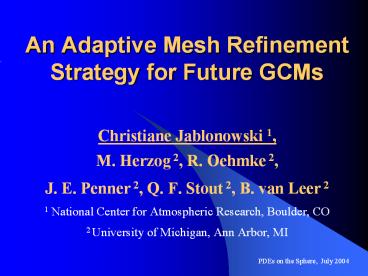An Adaptive Mesh Refinement Strategy for Future GCMs PowerPoint PPT Presentation
Title: An Adaptive Mesh Refinement Strategy for Future GCMs
1
An Adaptive Mesh Refinement Strategy for Future
GCMs
- Christiane Jablonowski 1,
- M. Herzog 2, R. Oehmke 2,
- J. E. Penner 2, Q. F. Stout 2, B. van Leer 2
- 1 National Center for Atmospheric Research,
Boulder, CO - 2 University of Michigan, Ann Arbor, MI
PDEs on the Sphere, July 2004
2
Adaptive Grids for Weather and Climate Models
- Goal Build a hydrostatic dynamical core for a
future General Circulation Model (GCM) that can
statically and dynamically adapt its horizontal
resolution with respect to - regions of interest
- features of interest
- Scientific computing challenge Interdisciplinary
UM team effort - Atmospheric science (Joyce Penner, Michael
Herzog) - Numerics (Bram van Leer, Ken Powell)
- Computer Science (Robert Oehmke, Quentin Stout)
- Collaboration with NASA / GSFC S.-J. Lin and
Kevin Yeh
3
Features of interest in a multi-scale regime
Hurricane Isabel 9/17/03
4
Adaptive Grids for Future GCMs
- Novel dynamically adaptive 3D dynamical core with
structured grids on the sphere - based on NASA/NCARs finite volume hydrostatic
dynamical core - Block data structure with AMR library support
- Novel dynamically adaptive 2D shallow water model
on the sphere - Shallow water model is 1-level version of
thedynamical core
5
Adaptive Mesh Refinement Strategy in Spherical
Geometry
Self-similar blocks with 3 ghost cells in x y
direction
6
Block-data structure and Reduced Grids
2 reduction levels
1 reduction level
7
Ghost cell exchange at fine-coarse interfaces
8
Spherical Adaptive Grid Library
- Block management is done by a Spherical Adaptive
Grid Library developed by Robert Oehmke
Quentin Stout (EECS, UM) - Designed for distributed memory parallel
computers - Library manages
- Definition and distribution of the sphere
Initial grid setup - MPI communication among neighboring blocks
- Load balancing e.g. equal number of blocks on
each processor - Adaptive grids generation/destruction of blocks,
keeps track of neighbors - Iterations through the blocks
- User supplied routines
- Pack/unpack routines for boundary exchanges
- Split / Join operations for boundary exchange if
neighboring blocks are at different resolutions - Interpolation routines for data in newly
refined/coarsened blocks
9
Overview of results Highlights
- 2D shallow water tests
- First glimpse Track the features of interest
- Advection experiments (test case 1, Williamson et
al. 1992) - Advection with a reduced grid
- Static refinements in regions of interest (test
case 2) - Dynamic refinements and refinement criteria
Flow over a mountain (test case 5) - 3D dynamical core tests
- Static refinements along the storm track
- Dynamic refinements with vorticity criterion
10
First glimpse Adaptations at work
11
Errors Cosine bell advection test
Test case 1, ? 90
- 2nd order convergence
12
Dynamic adaptations and the reduced grid
- No noise or distortions
- accurate transport
2 reductions
13
2D Static adaptations Region of interest
Test case 2, ? 45
- Smooth flow in regimes with strong gradients
14
2D Static adaptations Closer look
- Smooth wind field
- No noise or distortions at the fine-coarse grid
interface
15
2D Static adaptations Error norms
- Test case 2, ? 45
- Errors at grid interfaces are moderate
- Errors increase in regions with strong
gradients
16
2D Dynamic adaptations
Test case 5
17
Adaptation criterion Vorticity
Vorticity criterion detects regions with strong
curvature
18
Adaptation criterion Geopotential gradient
Gradient criterion detects disconnected regions
of the wave train
19
Baroclinic wave test case
- analytically specified balanced initial field
with overlaid perturbation - baroclinic wave develops after 5-10 days
- deterministic test that converges towards
reference solution
Jablonowski and Williamson 2004
20
Baroclinic waves in the 3D regime
- Jablonowski-Williamson baroclinic wave test case
for dyn. cores - Coarse resolution does not resolve the wave
train
21
Static adaptations in 3D
- 1 Refinement along the storm track improves the
simulation
22
Static adaptations in 3D
- 2 Refinements along the storm track capture the
wave accurately
23
Static adaptations in 3D
- 3 Refinements along the storm track no further
intensification
24
Dynamic adaptations in 3D
- Polvani et al. 2004 baroclinic wave test case
- Refinements are guided by relative vorticity
threshold
25
Dynamic adaptations in 3D
- Baroclinic wave is detected, more accurate
prediction - Sensitive relative vorticity threshold
0.7510-5 1/s
26
Conclusions
- Static and dynamic refinements on the sphere
work - AMR is a current research topic for the
atmospheric sciences - Future outlook
- Static and dynamic adaptations are a viable
option for short-term weather predictions - track storms as they appear
- focus on forecast region of interest replace
nested grids - Static adaptations are feasible for long-term
climate studies - refine mountainous terrain, reinitialize
orography - Future steps Add NCARs physics package,
build a full GCM
27
Optimization issuesLoad-balancing issues on
parallel machines
Same number of blocks per processor
discontinuous regions

